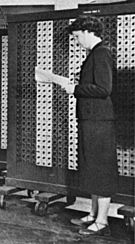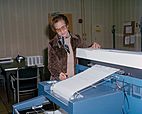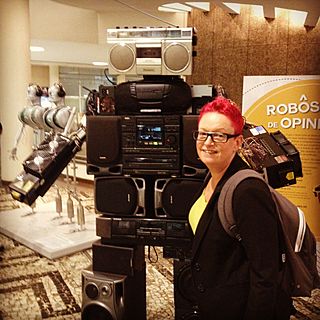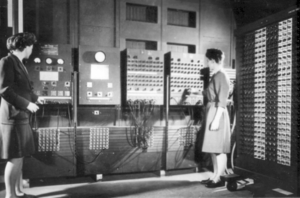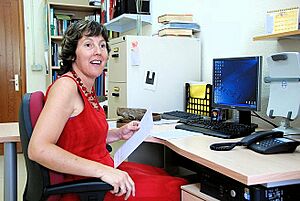Timeline of women in computing facts for kids
Amazing women who helped create the world of computing. Clockwise from top left: Ada Lovelace, Betty Holberton, Kateryna Yushchenko (scientist), Radia Perlman, Sue Black, Audrey Tang, Katherine Johnson.
This is a timeline showing the important contributions of women in computing. It starts from the time when women were called "human computers" because they did calculations by hand. Later, they became programmers for the first physical computers. Over time, women programmers went on to create software, develop Internet technologies, and work on many other types of programming. Women have also been key in computer science, different kinds of engineering related to computers, and even in building computer hardware.
Contents
- Early Computing Pioneers
- The Rise of Modern Computing
- Early 20th Century Innovations
- Mid-20th Century Advancements
- Late 20th Century Innovations
- Modern Communication and Software Development
- New Languages and Companies
- Internet Naming and Early Engineering
- Processor Design and Women's Groups
- Chip Design and Gaming
- Preserving Computer History
- Games and User Interfaces
- Networking and Encryption
- Women in Tech Support and Research
- IBM and Internet Pioneers
- Tech CEOs and Online Spaces for Women
- Cryptography and Open Source
- Smaller Screens and Web Accessibility
- Tech Leadership and Open Source Communities
- 21st Century Innovations
Early Computing Pioneers
18th Century Contributions
Calculating Halley's Comet
 In 1757, Nicole-Reine Etable de la Brière Lepaute was part of a team of human computers. They worked together to figure out when Halley's Comet would visit next. The special methods they created were used by other human computing teams for many years.
In 1757, Nicole-Reine Etable de la Brière Lepaute was part of a team of human computers. They worked together to figure out when Halley's Comet would visit next. The special methods they created were used by other human computing teams for many years.
19th Century Milestones
The First Computer Programmer
 In 1842, Ada Lovelace worked with Charles Babbage on his analytical engine. Many people consider her the "first computer programmer" because of her insights into how the machine could go beyond just calculations.
In 1842, Ada Lovelace worked with Charles Babbage on his analytical engine. Many people consider her the "first computer programmer" because of her insights into how the machine could go beyond just calculations.
Mapping the Stars
 In 1849, Maria Mitchell was hired by the U.S. Nautical Almanac Office. Her job was to calculate tables for the planet Venus.
In 1849, Maria Mitchell was hired by the U.S. Nautical Almanac Office. Her job was to calculate tables for the planet Venus. In 1875, Anna Winlock joined the Harvard Computers. This was a group of women who produced important astronomical data at Harvard University.
In 1875, Anna Winlock joined the Harvard Computers. This was a group of women who produced important astronomical data at Harvard University. In 1893, Henrietta Swan Leavitt also joined the Harvard "computers." She played a big role in discovering cepheid variable stars. These stars helped prove that the universe is expanding.
In 1893, Henrietta Swan Leavitt also joined the Harvard "computers." She played a big role in discovering cepheid variable stars. These stars helped prove that the universe is expanding.
The Rise of Modern Computing
Early 20th Century Innovations
Women in Wartime Calculations
 In 1916, Beatrice Cave-Brown-Cave became a human computer for the Ministry of Munitions.
In 1916, Beatrice Cave-Brown-Cave became a human computer for the Ministry of Munitions. In 1918, women were hired in Washington, D.C. to perform ballistics calculations. These were also human computers. Elizabeth Webb Wilson was the "chief computer" of this group.
In 1918, women were hired in Washington, D.C. to perform ballistics calculations. These were also human computers. Elizabeth Webb Wilson was the "chief computer" of this group. In 1920, Mary Clem took charge of the computing lab at Iowa State College.
In 1920, Mary Clem took charge of the computing lab at Iowa State College.
New Tools for Electricity
 In 1921, Edith Clarke received a patent for her graphical calculator. This tool helped solve problems with electric power line transmission.
In 1921, Edith Clarke received a patent for her graphical calculator. This tool helped solve problems with electric power line transmission.
Foundations of Computer Algebra
 In 1926, Grete Hermann published a key paper for computerized algebra. It was her doctoral thesis and appeared in a math journal.
In 1926, Grete Hermann published a key paper for computerized algebra. It was her doctoral thesis and appeared in a math journal.
NASA's First Computers
 In 1935, the National Advisory Committee for Aeronautics (NACA), which later became NASA, hired five women. They worked in a "computer pool" to analyze data from wind tunnels and flight tests.
In 1935, the National Advisory Committee for Aeronautics (NACA), which later became NASA, hired five women. They worked in a "computer pool" to analyze data from wind tunnels and flight tests. In 1939, Austrian scientist Johanna Piesch published two important papers on switching algebra.
In 1939, Austrian scientist Johanna Piesch published two important papers on switching algebra.
Women and WWII Computing
 In 1940, American women were recruited to do ballistics calculations and program computers during World War II. Around 1943–1945, these women used a differential analyzer to speed up their work. Even with the machine, they often checked calculations by hand. Phyllis Fox even ran a differential analyzer by herself.
In 1940, American women were recruited to do ballistics calculations and program computers during World War II. Around 1943–1945, these women used a differential analyzer to speed up their work. Even with the machine, they often checked calculations by hand. Phyllis Fox even ran a differential analyzer by herself. In 1941, Mavis Batey cracked the Italian Naval code while working at Bletchley Park.
In 1941, Mavis Batey cracked the Italian Naval code while working at Bletchley Park. Also in 1941, the United States started hiring African-American college graduates. They worked as human computers at Langley Air Force Base.
Also in 1941, the United States started hiring African-American college graduates. They worked as human computers at Langley Air Force Base. On August 11, 1942, Hedy Lamarr and her co-inventor, George Antheil, received a patent for frequency hopping.
On August 11, 1942, Hedy Lamarr and her co-inventor, George Antheil, received a patent for frequency hopping.
Programming the ENIAC
 In 1943, women worked as WREN Colossus operators during WW2 at Bletchley Park.
In 1943, women worked as WREN Colossus operators during WW2 at Bletchley Park. Wives of scientists on the Manhattan Project with math skills were hired as human computers. They worked on the ENIAC and MANIAC I computers. This group included Klara Dan von Neumann, Augusta H. Teller, and Adele Goldstine.
Wives of scientists on the Manhattan Project with math skills were hired as human computers. They worked on the ENIAC and MANIAC I computers. This group included Klara Dan von Neumann, Augusta H. Teller, and Adele Goldstine. Gertrude Blanch led the Mathematical Tables Project from 1938 to 1948. During WWII, her team did calculations for the U.S. government, including the Manhattan Project.
Gertrude Blanch led the Mathematical Tables Project from 1938 to 1948. During WWII, her team did calculations for the U.S. government, including the Manhattan Project. Ruth Leach Amonette was elected vice president at IBM in 1943. She was the first woman to hold such a role there.
Ruth Leach Amonette was elected vice president at IBM in 1943. She was the first woman to hold such a role there. In 1945, Marlyn Meltzer was hired as one of the first ENIAC programmers.
In 1945, Marlyn Meltzer was hired as one of the first ENIAC programmers. Kay McNulty Mauchly Antonelli was also hired as an ENIAC programmer. She is known for creating the first 'subroutine'.
Kay McNulty Mauchly Antonelli was also hired as an ENIAC programmer. She is known for creating the first 'subroutine'. In 1946, Betty Jennings, Betty Snyder, Frances Spence, Kay McNulty, Marlyn Wescoff, and Ruth Lichterman were the main programmers for the ENIAC. Adele Goldstine wrote the program manual for the ENIAC.
In 1946, Betty Jennings, Betty Snyder, Frances Spence, Kay McNulty, Marlyn Wescoff, and Ruth Lichterman were the main programmers for the ENIAC. Adele Goldstine wrote the program manual for the ENIAC.
Early Computer Development
 In 1947, Irma Wyman worked on a missile guidance project. She visited the U.S. Naval Proving Ground and found Grace Hopper using a prototype of a programmable Mark II computer.
In 1947, Irma Wyman worked on a missile guidance project. She visited the U.S. Naval Proving Ground and found Grace Hopper using a prototype of a programmable Mark II computer. In 1948, Kathleen Booth is credited with writing the assembly language for the ARC2 computer.
In 1948, Kathleen Booth is credited with writing the assembly language for the ARC2 computer. Dorothy Vaughn became the first black supervisor at NACA in 1948.
Dorothy Vaughn became the first black supervisor at NACA in 1948.
The Mother of COBOL
 In 1949, Grace Hopper, a United States Navy officer, was one of the first programmers for the Harvard Mark I. She is known as the "Mother of COBOL". She created the first compiler for an electronic computer, called A-0. She also made the term "debugging" popular.
In 1949, Grace Hopper, a United States Navy officer, was one of the first programmers for the Harvard Mark I. She is known as the "Mother of COBOL". She created the first compiler for an electronic computer, called A-0. She also made the term "debugging" popular. Evelyn Boyd Granville was the second African-American woman in the U.S. to get a PhD in mathematics. From 1956 to 1960, she worked for IBM on the Project Vanguard and Project Mercury space programs. She analyzed orbits and developed computer procedures.
Evelyn Boyd Granville was the second African-American woman in the U.S. to get a PhD in mathematics. From 1956 to 1960, she worked for IBM on the Project Vanguard and Project Mercury space programs. She analyzed orbits and developed computer procedures. On May 6, 1949, the EDSAC performed its first calculations using a program written by Beatrice Worsely.
On May 6, 1949, the EDSAC performed its first calculations using a program written by Beatrice Worsely.
Mid-20th Century Advancements
Pioneering Programming Languages
 In 1950, Ida Rhodes was a pioneer in programming systems. She helped design the C-10 language for the UNIVAC I. This computer system was used to calculate the census.
In 1950, Ida Rhodes was a pioneer in programming systems. She helped design the C-10 language for the UNIVAC I. This computer system was used to calculate the census. Also in 1950, Kathleen Booth created Assembly Language.
Also in 1950, Kathleen Booth created Assembly Language. In 1951, Frances Elizabeth "Betty" Snyder developed a UNIVAC program. It was the first sort-merge generator.
In 1951, Frances Elizabeth "Betty" Snyder developed a UNIVAC program. It was the first sort-merge generator.
Business and Scientific Computing
 In 1952, Mary Coombs was one of the first programmers for LEO. This was the first computer used for business. She continued to work on LEO II and LEO III.
In 1952, Mary Coombs was one of the first programmers for LEO. This was the first computer used for business. She continued to work on LEO II and LEO III. Hungarian-born Klara Dan von Neumann pioneered the programming of MANIAC I in 1952.
Hungarian-born Klara Dan von Neumann pioneered the programming of MANIAC I in 1952. Canadian Beatrice Worsley completed her doctorate in computer science in 1952. She was the first woman to earn that degree.
Canadian Beatrice Worsley completed her doctorate in computer science in 1952. She was the first woman to earn that degree.
 In 1954, Thelma Estrin worked on Israel's first computer, the WEIZAC.
In 1954, Thelma Estrin worked on Israel's first computer, the WEIZAC. In 1955, Annie Easley started working as a human computer for NACA.
In 1955, Annie Easley started working as a human computer for NACA.
 Also in 1955, Kateryna Yushchenko created the Address programming language. This language made possible indirect addressing, similar to Pointers.
Also in 1955, Kateryna Yushchenko created the Address programming language. This language made possible indirect addressing, similar to Pointers.
Desegregation and New Languages
 In 1958, the all-female "computers" at NASA's Jet Propulsion Laboratory solved orbital calculations for the United States' Explorer 1 satellite. Many were recruited right out of high school.
In 1958, the all-female "computers" at NASA's Jet Propulsion Laboratory solved orbital calculations for the United States' Explorer 1 satellite. Many were recruited right out of high school. Grace Hopper designed the computer language, FLOWMATIC in 1958.
Grace Hopper designed the computer language, FLOWMATIC in 1958. On May 5, 1958, Langley desegregated, closing down the West Area Computers.
On May 5, 1958, Langley desegregated, closing down the West Area Computers. Kathleen Booth published a book about programming APE(X)C computers in 1958.
Kathleen Booth published a book about programming APE(X)C computers in 1958. In 1959, Mary K. Hawes organized a meeting to discuss a new business programming language. This led to the creation of COBOL.
In 1959, Mary K. Hawes organized a meeting to discuss a new business programming language. This led to the creation of COBOL.
Breaking Barriers in Engineering
 In 1961, Dana Ulery was the first female engineer at Jet Propulsion Laboratory. She developed real-time tracking systems using a North American Aviation Recomp II computer.
In 1961, Dana Ulery was the first female engineer at Jet Propulsion Laboratory. She developed real-time tracking systems using a North American Aviation Recomp II computer. In 1962, Jean E. Sammet developed the FORMAC programming language. She also wrote a lot about the history of programming languages in 1969. She became the first female president of the Association for Computing Machinery in 1974.
In 1962, Jean E. Sammet developed the FORMAC programming language. She also wrote a lot about the history of programming languages in 1969. She became the first female president of the Association for Computing Machinery in 1974. Also in 1962, Dame Stephanie "Steve" Shirley founded the UK software company F.I. She wanted to create jobs for women with families. Most of her 300 programmers were women. She used the name "Steve" to help her in the male-dominated business world.
Also in 1962, Dame Stephanie "Steve" Shirley founded the UK software company F.I. She wanted to create jobs for women with families. Most of her 300 programmers were women. She used the name "Steve" to help her in the male-dominated business world.
Early Computer Dating and Packet Switching
 In 1964, Joan Ball started the first computer dating service.
In 1964, Joan Ball started the first computer dating service. Also in 1964, Sharla Boehm did important work in packet switching.
Also in 1964, Sharla Boehm did important work in packet switching. In 1965, Mary Allen Wilkes was the first person to use a computer in a private home. She also developed an operating system (LAP) for the first minicomputer (LINC).
In 1965, Mary Allen Wilkes was the first person to use a computer in a private home. She also developed an operating system (LAP) for the first minicomputer (LINC). Sister Mary Kenneth Keller became the first American woman to earn a Ph.D. in Computer Science in 1965.
Sister Mary Kenneth Keller became the first American woman to earn a Ph.D. in Computer Science in 1965. In 1966, Margaret R. Fox was appointed Chief of the Office of Computer Information. She was also the first Secretary for the American Federation of Information Processing Societies (AFIPS).
In 1966, Margaret R. Fox was appointed Chief of the Office of Computer Information. She was also the first Secretary for the American Federation of Information Processing Societies (AFIPS).
Computer Art and Software Engineering
 In 1968, Vera Molnár became a pioneer in computer and algorithmic arts. She started creating algorithmic drawings based on simple geometric shapes.
In 1968, Vera Molnár became a pioneer in computer and algorithmic arts. She started creating algorithmic drawings based on simple geometric shapes. In 1969, Jean E.Sammet published Programming Languages: History and Fundamentals. This book became a standard in the field.
In 1969, Jean E.Sammet published Programming Languages: History and Fundamentals. This book became a standard in the field. Also in 1969, Margaret Hamilton was the Director of the Software Engineering Division at the MIT Instrumentation Laboratory. Her team developed the flight software for the Apollo space program. Their work helped prevent an issue during the Apollo 11 moon landing. She later received the NASA Exceptional Space Act Award.
Also in 1969, Margaret Hamilton was the Director of the Software Engineering Division at the MIT Instrumentation Laboratory. Her team developed the flight software for the Apollo space program. Their work helped prevent an issue during the Apollo 11 moon landing. She later received the NASA Exceptional Space Act Award. Alexandra Illmer Forsythe co-authored the first computer science textbook in 1969.
Alexandra Illmer Forsythe co-authored the first computer science textbook in 1969.
Late 20th Century Innovations
Modern Communication and Software Development
 In 1970, Drude Berntsen was appointed director of the Norwegian Computing Center.
In 1970, Drude Berntsen was appointed director of the Norwegian Computing Center. In 1971, Erna Schneider Hoover invented a computerized telephone switching method. This helped develop modern communication. She was seen as an important pioneer for women in computer technology.
In 1971, Erna Schneider Hoover invented a computerized telephone switching method. This helped develop modern communication. She was seen as an important pioneer for women in computer technology. Also in 1971, Margaret Burnett became the first woman software developer hired by Procter & Gamble/Ivorydale. She was also the first woman hired into a management-level position there.
Also in 1971, Margaret Burnett became the first woman software developer hired by Procter & Gamble/Ivorydale. She was also the first woman hired into a management-level position there.
New Languages and Companies
 In 1972, Mary Shaw became the first woman to earn a Ph.D. in Computer Science from Carnegie Mellon University.
In 1972, Mary Shaw became the first woman to earn a Ph.D. in Computer Science from Carnegie Mellon University. Adele Goldberg was one of the developers of the Smalltalk language in 1972.
Adele Goldberg was one of the developers of the Smalltalk language in 1972. Karen Spärck Jones was a pioneer in information retrieval and natural language processing in 1972.
Karen Spärck Jones was a pioneer in information retrieval and natural language processing in 1972. Sandra Kurtzig founded ASK Computer Systems in 1972 with a small budget.
Sandra Kurtzig founded ASK Computer Systems in 1972 with a small budget. In 1973, Susan Nycum co-authored Computer Abuse. This was one of the first studies to define and document computer-related crime.
In 1973, Susan Nycum co-authored Computer Abuse. This was one of the first studies to define and document computer-related crime. Also in 1973, Phyllis Fox worked on the PORT mathematical library.
Also in 1973, Phyllis Fox worked on the PORT mathematical library.
Internet Naming and Early Engineering
 In 1974, Elizabeth Feinler and her team created a simple text file format for Internet host names. This list grew into the Domain Name System. Her group became the naming authority for .mil, .gov, .edu, .org, and .com.
In 1974, Elizabeth Feinler and her team created a simple text file format for Internet host names. This list grew into the Domain Name System. Her group became the naming authority for .mil, .gov, .edu, .org, and .com. In 1975, Irene Greif became the first woman to earn a Ph.D. in computer science from the Massachusetts Institute of Technology.
In 1975, Irene Greif became the first woman to earn a Ph.D. in computer science from the Massachusetts Institute of Technology. Indian computer scientist Sudha Murthy was hired as the first woman engineer at TELCO in 1975.
Indian computer scientist Sudha Murthy was hired as the first woman engineer at TELCO in 1975. In 1976, Rózsa Péter published Recursive Functions in Computer Theory.
In 1976, Rózsa Péter published Recursive Functions in Computer Theory.
Processor Design and Women's Groups
 In 1978, Sophie Wilson designed the Acorn Micro-Computer. She also designed the instruction set for the ARM processor.
In 1978, Sophie Wilson designed the Acorn Micro-Computer. She also designed the instruction set for the ARM processor.- The Association for Women in Computing (AWC) was founded in 1978.
 Christiane Floyd became the first woman computer science professor in Germany in 1978.
Christiane Floyd became the first woman computer science professor in Germany in 1978.
Chip Design and Gaming
 In 1979, Lynn Conway co-authored Introduction to VLSI Systems. This textbook helped start the Mead and Conway revolution in integrated circuit design.
In 1979, Lynn Conway co-authored Introduction to VLSI Systems. This textbook helped start the Mead and Conway revolution in integrated circuit design. Patricia Selinger was a key architect of IBM System R in 1979. She wrote an important paper on relational query optimization.
Patricia Selinger was a key architect of IBM System R in 1979. She wrote an important paper on relational query optimization. Carol Shaw was a game designer and programmer for Atari Corp. and Activision in 1979.
Carol Shaw was a game designer and programmer for Atari Corp. and Activision in 1979. Ruzena Bajcsy founded the GRASP lab at the University of Pennsylvania in 1979.
Ruzena Bajcsy founded the GRASP lab at the University of Pennsylvania in 1979. Priti Shankar worked on improving Bose Chaudhuri-Hocquenghem (BHC) codes for error-correcting in 1979.
Priti Shankar worked on improving Bose Chaudhuri-Hocquenghem (BHC) codes for error-correcting in 1979.
Preserving Computer History
 In 1980, Carla Meninsky was the game designer and programmer for Atari 2600 games like Star Raiders and Warlords.
In 1980, Carla Meninsky was the game designer and programmer for Atari 2600 games like Star Raiders and Warlords. Gwen Bell started the Computer Museum in 1980 to save items from computer history.
Gwen Bell started the Computer Museum in 1980 to save items from computer history. Ruth M. Davis founded Pymatuning Group in Virginia in 1980.
Ruth M. Davis founded Pymatuning Group in Virginia in 1980. In 1982, Lorinda Cherry worked on the Writer's Workbench (wwb) for Bell Labs.
In 1982, Lorinda Cherry worked on the Writer's Workbench (wwb) for Bell Labs. Marsha R. Williams became the first African American woman to earn a Ph.D. in computer science in 1982.
Marsha R. Williams became the first African American woman to earn a Ph.D. in computer science in 1982.
Games and User Interfaces
 In 1983, Janese Swanson helped develop the first Carmen Sandiego games. She later founded Girl Tech.
In 1983, Janese Swanson helped develop the first Carmen Sandiego games. She later founded Girl Tech. In 1984, Roberta Williams did pioneering work in graphical adventure games for personal computers. She was known for the King's Quest series.
In 1984, Roberta Williams did pioneering work in graphical adventure games for personal computers. She was known for the King's Quest series. Susan Kare created the icons and interface elements for the original Apple Macintosh in the 1980s. She also worked as the Creative Director at NeXT.
Susan Kare created the icons and interface elements for the original Apple Macintosh in the 1980s. She also worked as the Creative Director at NeXT. Eleanor K. Baum became the first woman in the United States to be named dean of an engineering college in 1984.
Eleanor K. Baum became the first woman in the United States to be named dean of an engineering college in 1984.
Networking and Encryption
 In 1985, Radia Perlman invented the Spanning Tree Protocol. She has done a lot of important research on encryption and networking.
In 1985, Radia Perlman invented the Spanning Tree Protocol. She has done a lot of important research on encryption and networking. Irma Wyman was the first Honeywell CIO in 1985.
Irma Wyman was the first Honeywell CIO in 1985.- Janet Walker developed the Symbolics Document Examiner in 1985.
 In 1986, Lixia Zhang was the only woman at the first meetings of the Internet Engineering Task Force.
In 1986, Lixia Zhang was the only woman at the first meetings of the Internet Engineering Task Force. Nancy Hafkin became head of the Pan African Development Information System in 1986.
Nancy Hafkin became head of the Pan African Development Information System in 1986.
Women in Tech Support and Research
 In 1987, Monica S. Lam received a Ph.D. for her work on optimizing compilers. She has done important research in computer science.
In 1987, Monica S. Lam received a Ph.D. for her work on optimizing compilers. She has done important research in computer science. Anita Borg founded the electronic mailing list for women in technology, Systers, in 1987.
Anita Borg founded the electronic mailing list for women in technology, Systers, in 1987. French computer scientist, Joëlle Coutaz developed the Presentation-abstraction-control model for human computer interactions in 1987.
French computer scientist, Joëlle Coutaz developed the Presentation-abstraction-control model for human computer interactions in 1987. In 1988, Éva Tardos received the Fulkerson Prize for her research on algorithms.
In 1988, Éva Tardos received the Fulkerson Prize for her research on algorithms. Janie Tsao co-founded Linksys in 1988.
Janie Tsao co-founded Linksys in 1988.
IBM and Internet Pioneers
 In 1989, Frances E. Allen became the first female IBM Fellow. In 2006, she was the first woman to receive the ACM's Turing Award.
In 1989, Frances E. Allen became the first female IBM Fellow. In 2006, she was the first woman to receive the ACM's Turing Award. Frances Brazier, a professor at the Vrije Universiteit in Amsterdam, helped found NLnet in 1989. This was the first Internet service provider in the Netherlands.
Frances Brazier, a professor at the Vrije Universiteit in Amsterdam, helped found NLnet in 1989. This was the first Internet service provider in the Netherlands. In 1990, Ruzena Bajcsy became the first woman to lead the computer and information science department at the University of Pennsylvania.
In 1990, Ruzena Bajcsy became the first woman to lead the computer and information science department at the University of Pennsylvania.
Tech CEOs and Online Spaces for Women
 In 1992, Donna Dubinsky was CEO and co-founder of Palm, Inc.. She also co-founded Handspring and Numenta.
In 1992, Donna Dubinsky was CEO and co-founder of Palm, Inc.. She also co-founded Handspring and Numenta. Nancy Rhine and Ellen Pack co-founded Women's WIRE in 1992. This was the first online space made for women.
Nancy Rhine and Ellen Pack co-founded Women's WIRE in 1992. This was the first online space made for women. Carol Bartz became the CEO of Autodesk in 1992.
Carol Bartz became the CEO of Autodesk in 1992.
Cryptography and Open Source
 In 1993, Shafi Goldwasser, a theoretical computer scientist, received the Gödel Prize twice. She is known for her research on cryptography and for inventing zero-knowledge proofs.
In 1993, Shafi Goldwasser, a theoretical computer scientist, received the Gödel Prize twice. She is known for her research on cryptography and for inventing zero-knowledge proofs. Barbara Liskov and Jeannette Wing developed the Liskov substitution principle in 1993. Liskov also won the Turing Prize in 2008.
Barbara Liskov and Jeannette Wing developed the Liskov substitution principle in 1993. Liskov also won the Turing Prize in 2008. Carolyn Gruyer wrote a feminist hypertext, Quibbling, in 1993.
Carolyn Gruyer wrote a feminist hypertext, Quibbling, in 1993. In 1994, Sally Floyd became known for her work on Transmission Control Protocol.
In 1994, Sally Floyd became known for her work on Transmission Control Protocol.- The Grace Hopper Celebration of Women in Computing was first held in 1994, started by Anita Borg.
 On April 20, 1994, Hu Qiheng led the project that installed the first TCP/IP connection to the Internet in China.
On April 20, 1994, Hu Qiheng led the project that installed the first TCP/IP connection to the Internet in China.
Smaller Screens and Web Accessibility
 In 1995, Mary Lou Jepsen was the CTO of MicroDisplay. She developed smaller computer screens there.
In 1995, Mary Lou Jepsen was the CTO of MicroDisplay. She developed smaller computer screens there. Eleanor K. Baum was the first woman to be elected president of the American Society for Engineering Education in 1995.
Eleanor K. Baum was the first woman to be elected president of the American Society for Engineering Education in 1995. In 1996, Xiaoyuan Tu was the first woman to receive ACM's Doctoral Dissertation Award.
In 1996, Xiaoyuan Tu was the first woman to receive ACM's Doctoral Dissertation Award. In 1997, Anita Borg founded the Institute for Women and Technology (IWT). It was later renamed the Anita Borg Institute (ABI) in her honor.
In 1997, Anita Borg founded the Institute for Women and Technology (IWT). It was later renamed the Anita Borg Institute (ABI) in her honor. Japanese-born Chieko Asakawa developed the IBM Home Page Reader in 1997. This opened up Web resources for blind people.
Japanese-born Chieko Asakawa developed the IBM Home Page Reader in 1997. This opened up Web resources for blind people. Natalya Kaspersky co-founded and led the successful antivirus software company Kaspersky Lab in 1997.
Natalya Kaspersky co-founded and led the successful antivirus software company Kaspersky Lab in 1997.
 Manuela Veloso received the CMU Allen Newell Medal for Excellence in Research in 1997.
Manuela Veloso received the CMU Allen Newell Medal for Excellence in Research in 1997.
Tech Leadership and Open Source Communities
- The Center for Women and Information Technology (CWIT) was started at the University of Maryland, Baltimore County (UMBC) in 1998.
 Meg Whitman became the CEO of eBay in 1998.
Meg Whitman became the CEO of eBay in 1998.- LinuxChix, an international group for women who use Linux, was founded by Deb Richardson in 1999.
 Marissa Mayer was the first female engineer hired at Google in 1999. She later became vice president of Search Product and User Experience. She was also the CEO of Yahoo!.
Marissa Mayer was the first female engineer hired at Google in 1999. She later became vice president of Search Product and User Experience. She was also the CEO of Yahoo!. Lixia Zhang created the term "middlebox" in 1999.
Lixia Zhang created the term "middlebox" in 1999. Carly Fiorina started as the CEO of Hewlett-Packard in 1999.
Carly Fiorina started as the CEO of Hewlett-Packard in 1999. Sun Yafeng became the chair of Huawei Technologies Board in 1999.
Sun Yafeng became the chair of Huawei Technologies Board in 1999.
21st Century Innovations
Early 2000s Milestones
Awards and Educational Software
 In 2000, Lydia Kavraki received the Grace Murray Hopper Award.
In 2000, Lydia Kavraki received the Grace Murray Hopper Award. In 2001, Noriko H. Arai started developing NetCommons. This software is used for content management at over 3,500 educational places.
In 2001, Noriko H. Arai started developing NetCommons. This software is used for content management at over 3,500 educational places. In 2003, Ellen Spertus earned a PhD from MIT. Her thesis was about finding information on the World-Wide Web.
In 2003, Ellen Spertus earned a PhD from MIT. Her thesis was about finding information on the World-Wide Web. Margaret Hamilton received the NASA Exceptional Space Act Award in 2003.
Margaret Hamilton received the NASA Exceptional Space Act Award in 2003. Sue Black started her campaign to save Bletchley Park in 2003.
Sue Black started her campaign to save Bletchley Park in 2003.
Chip Design and Tech Leadership
 In 2004, Jeri Ellsworth designed computer chips and created the C64 Direct-to-TV.
In 2004, Jeri Ellsworth designed computer chips and created the C64 Direct-to-TV. Lucy Sanders co-founded the National Center for Women & Information Technology in 2004.
Lucy Sanders co-founded the National Center for Women & Information Technology in 2004.
 Safra Catz became the President of Oracle Corporation in 2004.
Safra Catz became the President of Oracle Corporation in 2004.
Open Source and Security
 In 2005, Audrey Tang started and led the Pugs project.
In 2005, Audrey Tang started and led the Pugs project. Mary Lou Jepsen founded and was chief technology officer of One Laptop Per Child (OLPC) in 2005.
Mary Lou Jepsen founded and was chief technology officer of One Laptop Per Child (OLPC) in 2005. Facebook hired their first woman engineer, Ruchi Sanghvi, in 2005.
Facebook hired their first woman engineer, Ruchi Sanghvi, in 2005. Xiaoyun Wang and her team cracked the SHA-1 data security algorithm in 2005.
Xiaoyun Wang and her team cracked the SHA-1 data security algorithm in 2005.
Turing Award and RFID Security

 In 2006, Maria Klawe became the first woman president of Harvey Mudd College. She was also ACM president from 2002 to 2004.
In 2006, Maria Klawe became the first woman president of Harvey Mudd College. She was also ACM president from 2002 to 2004. Melanie Rieback researched the security of Radio Frequency Identification (RFID) technology. She programmed the first virus to infect RFID devices in 2006.
Melanie Rieback researched the security of Radio Frequency Identification (RFID) technology. She programmed the first virus to infect RFID devices in 2006. Joanna Rutkowska presented Blue Pill, a rootkit based on x86 virtualization, at a computer security conference in 2006.
Joanna Rutkowska presented Blue Pill, a rootkit based on x86 virtualization, at a computer security conference in 2006. In January 2006, Janet Emerson Bashen became the first African American woman to hold a patent for a software invention.
In January 2006, Janet Emerson Bashen became the first African American woman to hold a patent for a software invention. Frances "Fran" Allen became the first woman to earn an A.M. Turing Award in 2006.
Frances "Fran" Allen became the first woman to earn an A.M. Turing Award in 2006. Sophie Vandebroek became the Chief Technology Officer for Xerox in 2006.
Sophie Vandebroek became the Chief Technology Officer for Xerox in 2006. Anne-Marie Kermarrec started as the Research Director for INRIA in 2006.
Anne-Marie Kermarrec started as the Research Director for INRIA in 2006. Yoelle Maarek opened the Google Haifa Engineering Center in 2006, where she is the Director.
Yoelle Maarek opened the Google Haifa Engineering Center in 2006, where she is the Director.
Database Systems and Computational Sustainability

 In 2007, Meral Özsoyoğlu became the editor-in-chief of the ACM Transactions of Database Systems. She was the first woman to hold that position.
In 2007, Meral Özsoyoğlu became the editor-in-chief of the ACM Transactions of Database Systems. She was the first woman to hold that position.
 In 2008, Portuguese-born Carla Gomes founded and directed Cornell's Institute for Computational Sustainability.
In 2008, Portuguese-born Carla Gomes founded and directed Cornell's Institute for Computational Sustainability. Barbara Liskov won the 2008 A.M. Turing Award.
Barbara Liskov won the 2008 A.M. Turing Award. The British Computer Society created an award in the name of computer scientist, Karen Spärck Jones, in 2008.
The British Computer Society created an award in the name of computer scientist, Karen Spärck Jones, in 2008.
Internet Architecture and Tech Leadership
 In 2009, Lixia Zhang received an IEEE Internet Award for her work on the Internet's architecture.
In 2009, Lixia Zhang received an IEEE Internet Award for her work on the Internet's architecture. Carol Bartz joined Yahoo! as CEO in 2009.
Carol Bartz joined Yahoo! as CEO in 2009.
 Maria Petrou started as the director of the Informatics and Telematics Institute in Greece in 2009.
Maria Petrou started as the director of the Informatics and Telematics Institute in Greece in 2009.
2010s and Beyond
African Tech and Coding Communities
 In 2010, Farida Bedwei co-founded Logiciel in Ghana.
In 2010, Farida Bedwei co-founded Logiciel in Ghana.
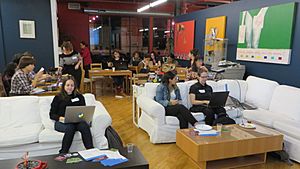
PyLadies of Montreal at a 2015 GitHub party
- Ladies Learning Code was launched in Toronto in 2011.
- PyLadies, an international group for women interested in coding Python, started in Los Angeles in 2011.
 Meg Whitman became CEO of Hewlett-Packard in 2011.
Meg Whitman became CEO of Hewlett-Packard in 2011. Bettina Speckmann was the first winner of the Netherlands Prize for ICT Research in 2011. She was recognized for her work on geographic information systems.
Bettina Speckmann was the first winner of the Netherlands Prize for ICT Research in 2011. She was recognized for her work on geographic information systems. Noriko H. Arai became the Program director for an artificial intelligence challenge in 2011.
Noriko H. Arai became the Program director for an artificial intelligence challenge in 2011. Shikoh Gitau received the Google Anita Borg Award in 2011. She was the first person in Sub Saharan Africa to earn a Google award.
Shikoh Gitau received the Google Anita Borg Award in 2011. She was the first person in Sub Saharan Africa to earn a Google award.
AI, Robotics, and Diversity
 In 2012, Shafi Goldwasser was a co-recipient of the A.M. Turing Award.
In 2012, Shafi Goldwasser was a co-recipient of the A.M. Turing Award.- Pixelles hosted their first game-programming incubator in Montreal in 2012.
 Computer scientist, Muffy Calder, became the Chief Scientific Advisor for the Scottish Government in 2012.
Computer scientist, Muffy Calder, became the Chief Scientific Advisor for the Scottish Government in 2012. Ginni Rometty became the first woman to serve as president and CEO of IBM in 2012.
Ginni Rometty became the first woman to serve as president and CEO of IBM in 2012. Eva Tardos earned the Gödel Prize in 2012.
Eva Tardos earned the Gödel Prize in 2012. Regina Honu founded Soronko Solutions, a software development company, in 2012.
Regina Honu founded Soronko Solutions, a software development company, in 2012. Carol Reiley was the first woman engineer to be featured on the cover of MAKE magazine in 2012.
Carol Reiley was the first woman engineer to be featured on the cover of MAKE magazine in 2012.- Nigerian Women In Information Technology (NiWIIT) was created in 2012. It aims to empower women in Information and Communication Technologies.
Influential Figures and Open Source
 In 2013, TIME Magazine named Afghani software developer, Roya Mahboob, one of the 100 most influential people of the year.
In 2013, TIME Magazine named Afghani software developer, Roya Mahboob, one of the 100 most influential people of the year. Christine Paulin-Mohring received the ACM Software System Award in 2013 for her work on the Coq Proof Assistant System.
Christine Paulin-Mohring received the ACM Software System Award in 2013 for her work on the Coq Proof Assistant System. In 2014, Megan Smith was named the third (and first female) Chief Technology Officer of the United States of America (USCTO).
In 2014, Megan Smith was named the third (and first female) Chief Technology Officer of the United States of America (USCTO). Coraline Ada Ehmke wrote the first code of conduct for open source projects, the Contributor Covenant, in 2014.
Coraline Ada Ehmke wrote the first code of conduct for open source projects, the Contributor Covenant, in 2014. Perianne Boring founded the Chamber of Digital Commerce in July 2014.
Perianne Boring founded the Chamber of Digital Commerce in July 2014.- In August 2014, the first Pan-African Women in Tech conference took place online.
Awards and Digital Leadership
 In 2015, Sarah Sharp was the first winner of the annual Women in Open Source Community Award.
In 2015, Sarah Sharp was the first winner of the annual Women in Open Source Community Award.- Kesha Shah was the first winner of the annual Women in Open Source Academic Award in 2015.
 Gillian Docherty became the new CEO of the DataLab in Scotland in 2015.
Gillian Docherty became the new CEO of the DataLab in Scotland in 2015. In 2016, Audrey Tang became "digital minister" in Taiwan.
In 2016, Audrey Tang became "digital minister" in Taiwan. Maja Matarić co-founded Embodied Robotics in 2016.
Maja Matarić co-founded Embodied Robotics in 2016.
Quantum Computing and Coding Schools
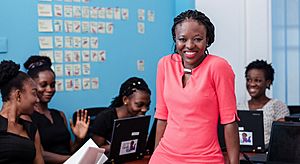
Regina Honu with a classroom of students learning to code
 In 2017, Michelle Simmons founded the first quantum computer company in Australia.
In 2017, Michelle Simmons founded the first quantum computer company in Australia. Regina Honu opened Soronko Academy in 2017. This was the first coding and "human centered design school" for children and teens in West Africa.
Regina Honu opened Soronko Academy in 2017. This was the first coding and "human centered design school" for children and teens in West Africa.
Recognition and Addressing Bias
 In 2018, Dame Rosie Stephenson-Goodknight was recognized for her work on Wikipedia.
In 2018, Dame Rosie Stephenson-Goodknight was recognized for her work on Wikipedia. Gladys West, a human computer whose calculations helped develop GPS technology, was recognized in December 2018. She was inducted into the Air Force Space and Missile Pioneers Hall of Fame.
Gladys West, a human computer whose calculations helped develop GPS technology, was recognized in December 2018. She was inducted into the Air Force Space and Missile Pioneers Hall of Fame. Safiya Umoja Noble published Algorithms of Oppression: How Search Engines Reinforce Racism in 2018. She argued that search algorithms can be unfair and continue societal problems.
Safiya Umoja Noble published Algorithms of Oppression: How Search Engines Reinforce Racism in 2018. She argued that search algorithms can be unfair and continue societal problems. -
- Joy Buolamwini published Gender Shades: Intersectional Accuracy Disparities in Commercial Gender Classification in 2018. This work showed biases in facial recognition systems.
Joy Buolamwini published Gender Shades: Intersectional Accuracy Disparities in Commercial Gender Classification in 2018. This work showed biases in facial recognition systems.

All content from Kiddle encyclopedia articles (including the article images and facts) can be freely used under Attribution-ShareAlike license, unless stated otherwise. Cite this article:
Timeline of women in computing Facts for Kids. Kiddle Encyclopedia.


